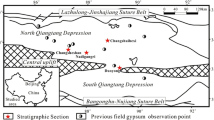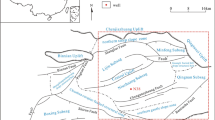Abstract
Ordovician evaporites are very rare in the global geological record. Thick salt deposits in the Ordovician Majiagou Formation are present in the eastern greater Ordos Basin, China. Potash mineralization layers and a thin industrial grade potash layer occur in the sixth submember of the fifth member of the formation, thus indicating a good potash prospect. The eastern and western salt depressions are separated by an uplift and have been divided into five secondary salt sags (East-1, East-2, West-1, West-2, and West-3). The ratio of the salt layer thickness to that of the whole succession was very low in the West-2 sag and the salt depositional center was the East-2 sag, which implied that seawater entered the basin from the western sags and led to desalination and the formation of deep-water sediments. Analyses indicated that the potash formation conditions were obviously different in the salt sags. Although a thin potash layer was present in the East-1 sag, findings indicated that this area was not favorable for potash accumulation. The geochemical and sedimentary environment of the East-2 sag was similar to that of typical potash basins globally. Rounded sylvine grains occurred between salt crystals. The preservation characteristics indicated that evaporite deposits had reached the KCl bitterns stage. An eastward input of terrestrial materials carried a large amount of clay, and the clay layer protected previously deposited sylvine particles, thereby avoiding further potassium dissolution. Sedimentary, geochemical, and petrological evidences indicate good prospects for potash exploration in the East-2 salt sag.


AUS Australia, SAM South America, NAM North America, AFR Africa, ID India, AT Antarctica, EU Paleo-Europe. b Paleolatitude distributions of the NCB (after Wu et al. 1990)















Similar content being viewed by others
References
Bai Y, Sun D (1996) Structural feature and evolution of Lishi fracture zone. Oil Gas Geol 17:77–80 (in Chinese with English abstract)
Bao H, Yang C, Huang J (2004) “Evaporation drying” and “reinfluxing and redissolving”: a new hypothesis concerning formation of the Ordovician evaporites in eastern Ordos Basin. J Palaeogeogr 6:279–288 (in Chinese with English abstract)
Chen W, Yuan H (2010) Regional Ore-forming geological conditions of the Ordovician northern Shanxi salt basin. Acta Geol Sin 84:1565–1575 (in Chinese with English abstract)
Feng ZZ, Chen JX, Zhang JS (1991) Lithofacies paleogeography of early Paleozoic in Ordos. Geological Publishing House, Beijing (in Chinese with English abstract)
Feng ZZ, Zhang YS, Jin ZK (1998) Type, origin, and reservoir characteristics of dolostones of the Ordovician Majiagou Group, Ordos, North China platform. Sediment Geol 118:127–140
Galamay AR, Meng FW, Bukowski K, Lyubchak A, Zhang YS, Ni P (2019) Calculation of salt basin depth using fluid inclusions in halite from the Ordovician Ordos Basin in China. Geol Q 63(3):619–628
Guo YR, Fu JH, Wei XS, Wei XS, Xu WL, Sun LY, Liu JB, Zhao ZY, Zhang YQ, Gao JR, Zhang YL (2014) Natural gas accumulation and models in Ordovician carbonates, Ordos Basin. NW China Petrol Explor Dev 41(4):437–448 (in Chinese with English abstract)
Hovorka SD, Holt RM, Powers DW (2007) Depth indicators in Permian Basin evaporites. In: Schreiber BC, Lugli S, Babel M (eds) Evaporites through space and time, vol 85. Geological Society, London, pp 335–364 (special publications 373)
Kovalevych VM, Peryt TM, Zang WL, Vovnyuk SV (2006) Composition of brines in halite-hosted fluid inclusions in the Upper Ordovician, Canning Basin, Western Australia: new data on seawater chemistry. Terra Nova 18:95–103
Li RX, Guzmics T, Liu XJ, Xie GC (2011) Migration of immiscible hydrocarbons recorded in calcite-hostedfluid inclusions, Ordos Basin: a case study from Northern China. Russ Geol Geophys 52:1491–1503
Li SP, Ma HZ, Chen YS, Wang SZ, Li WF, Wang QY (2010) Geochemical characteristics of trace elements and ore genesis from potash deposit in Vientiane basin, Laos. Geol Bull China 29:760–770 (in Chinese with English abstract)
Liu Q, Du ZY, Chen YH, Jin RG, Yuan HR, Zhang FG, Zhu YH, Chen YH (1997) Potash prospecting of Ordovician in the north Shanxi and Carboniferous in the Tarim basin. Atomic Energy Press, Beijing, pp 1–237 (in Chinese with English abstract)
Meng FW, Zhang YS, Galamy AR, Bukowski K, Ni P, Xing EY, Ji LM (2018) Ordovician seawater composition:evidence from fluid inclusions in halite. Geol Q 62(2):344–352
Meng FW, Zhang ZL, Yan XQ, Ni P, Liu WH, Fan F, Xie GW (2019) Stromatolites in Middle Ordovician carbonate–evaporite sequences and their carbon and sulfur isotopes stratigraphy, Ordos Basin, northwestern China. Carbonate Evaporite 34(1):11–20
Qi W (2010) The evolution of North America and the formation of potash deposits. Acta Geol Sin 84:1576–1583 (in Chinese with English abstract)
Ronov AB, Khain VE, Balukhovsky AN, Seslavinsky KB (1980) Quantitative analysis of Phanerozoic sedimentation. Sediment Geol 25:311–325
Scotese CR (1979) Palaeozoic base maps. J Geol 87(3):217–277
Usiglio MJ (1849) Étutes sur la composition de l’eau de la Mediterannee et sur l’exploitation des sels qu’elle contient. Ann Chim Phys 27:172–191
Valyashko MG (1962) The principle of forming of salt deposits(in Russian): Moscow, MGU
Wittrup MB, Kyser TK (1990) The petrogenesis of brine in Devonian potash deposit of western Canada. Chem Geol 82:103–128
Wu HN, Liu C, Chang CF, Zhong DL (1990) Evolution of the Qinling fold belt and the movement of the north and south China blocks: The evidence of geology and paleomagnetism. Sci Geol Sin 3:201–214 (in Chinese with English abstract)
Yang Y, Li W, Ma L (2005) Tectonic and stratigraphic controls of hydrocarbon systems in the Ordos basin: a multicycle cratonic basin in central China. AAPG Bulletin 89:255–269
Yuan HR, Zheng MP, Chen WX, Zhang YS, Liu JH (2010) Potash prospects in the Ordovician northern Shanxi Salt Basin. Acta Geol Sin 84:1554–1563 (in Chinese with English abstract)
Zhang X, Ma H, Tan H, Gao D, Li B, Wang M, Tang Q, Yuan X (2010) Preliminary studies of geochemistry and post-depositional change of Dong Tai potash deposit in Laos. Mineral Deposit 29:713–720 (in Chinese with English abstract)
Zhang Y, Zheng MP, Bao HP, Guo Q, Yu CQ, Xing YE, Su K, Fan F, Gong WQ (2013) Tectonic differentiation of O2M56 deposition stage in salt basin, northern Shanxi, and its control over the formation of potassium sags. Acta Geol Sin 87(1):101–109 (in Chinese with English abstract)
Zharkov MA (1984) Paleozoic Salt-bearing Formations of World. Spring-Verlag, Berlin
Zhu RX, Yang ZY, Wu HN, Ma XH, Huang BC, Meng ZF, Fang DJ (1998) Paleomagnetic constraints on the tectonic history of the major blocks of China during Phanerozoic. Sci China (Series D) 41:1–17
Acknowledgements
This study was funded by the Ministry of Science and Technology Project (2017YFC0602802), the National Natural Science Foundation of China (Grant Number, 41561144009), Israel Science Foundation (No. 2221/15), and Basic Frontier Scientific Research Program of the Chinese Academy of Sciences (No. ZDBS-LY-DQC021).
Author information
Authors and Affiliations
Corresponding author
Additional information
Publisher's Note
Springer Nature remains neutral with regard to jurisdictional claims in published maps and institutional affiliations.
Electronic supplementary material
Below is the link to the electronic supplementary material.
Rights and permissions
About this article
Cite this article
Fan, F., Meng, FW., Zhang, YS. et al. Differences in evaporite geochemistry of the greater Ordos Ordovician salt basin, China: evidence from the M56 submember of the Majiagou Formation. Carbonates Evaporites 35, 107 (2020). https://doi.org/10.1007/s13146-020-00632-2
Accepted:
Published:
DOI: https://doi.org/10.1007/s13146-020-00632-2




